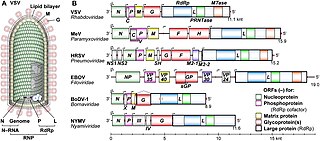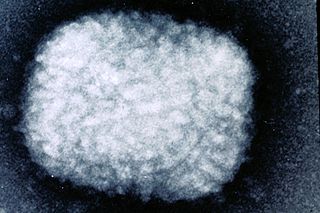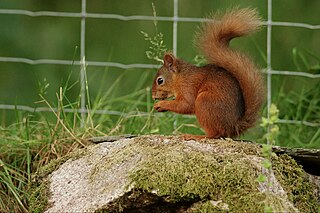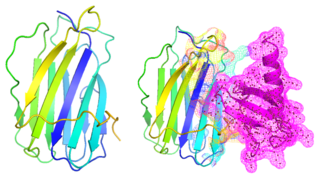
Filoviridae is a family of single-stranded negative-sense RNA viruses in the order Mononegavirales. Two members of the family that are commonly known are Ebola virus and Marburg virus. Both viruses, and some of their lesser known relatives, cause severe disease in humans and nonhuman primates in the form of viral hemorrhagic fevers.

Orf is a farmyard pox, a type of zoonosis. It causes small pustules in the skin of primarily sheep and goats, but can also occur on the hands of humans. A pale halo forms around a red centre. It may persist for several weeks before crusting and then either resolves or leaves a hard lump. There is usually only one lesion, but there may be many, and they are not painful. Sometimes there are swollen lymph glands.

Mononegavirales is an order of negative-strand RNA viruses which have nonsegmented genomes. Some common members of the order are Ebola virus, human respiratory syncytial virus, measles virus, mumps virus, Nipah virus, and rabies virus. All of these viruses cause significant disease in humans. Many other important pathogens of nonhuman animals and plants are also in the group. The order includes eleven virus families: Artoviridae, Bornaviridae, Filoviridae, Lispiviridae, Mymonaviridae, Nyamiviridae, Paramyxoviridae, Pneumoviridae, Rhabdoviridae, Sunviridae, and Xinmoviridae.

The genus Marburgvirus is the taxonomic home of Marburg marburgvirus, whose members are the two known marburgviruses, Marburg virus (MARV) and Ravn virus (RAVV). Both viruses cause Marburg virus disease in humans and nonhuman primates, a form of viral hemorrhagic fever. Both are Select agents, World Health Organization Risk Group 4 Pathogens, National Institutes of Health/National Institute of Allergy and Infectious Diseases Category A Priority Pathogens, Centers for Disease Control and Prevention Category A Bioterrorism Agents, and are listed as Biological Agents for Export Control by the Australia Group.

Poxviridae is a family of double-stranded DNA viruses. Vertebrates and arthropods serve as natural hosts. There are currently 83 species in this family, divided among 22 genera, which are divided into two subfamilies. Diseases associated with this family include smallpox.

Squirrelpox virus (SQPV) is a virus that causes the fatal disease squirrelpox in United Kingdom red squirrels. The virus is often carried by grey squirrels from North America, which rarely die from the disease. Elsewhere in the Red Squirrel's European range, either the grey squirrel does not occur or it lacks the poxvirus.

The International Committee on Taxonomy of Viruses (ICTV) authorizes and organizes the taxonomic classification of and the nomenclatures for viruses. The ICTV has developed a universal taxonomic scheme for viruses, and thus has the means to appropriately describe, name, and classify every virus that affects living organisms. The members of the International Committee on Taxonomy of Viruses are considered expert virologists. The ICTV was formed from and is governed by the Virology Division of the International Union of Microbiological Societies. Detailed work, such as delimiting the boundaries of species within a family, typically is performed by study groups of experts in the families.
Bovine alphaherpesvirus 2 (BoHV2) is a virus of the family Herpesviridae that causes two diseases in cattle, bovine mammillitis and pseudo-lumpy skin disease. BoHV2 is similar in structure to human herpes simplex virus.

Duck plague is a worldwide disease caused by Anatid alphaherpesvirus 1 (AnHV-1) of the family Herpesviridae that causes acute disease with high mortality rates in flocks of ducks, geese, and swans. It is spread both vertically and horizontally—through contaminated water and direct contact. Migratory waterfowl are a major factor in the spread of this disease as they are often asymptomatic carriers of disease. The incubation period is three to seven days. Birds as young as one week old can be infected. DEV is not zoonotic.

Ectromelia virus (ECTV) is a virus of the family Poxviridae and the genus Orthopoxvirus that causes mousepox, a disease of mice. It has only been seen in mouse colonies kept for research purposes but believed that wild populations of mice and other rodents in Europe are naturally infected with ECTV. Mousepox causes skin lesions, a purulent rash on the body of mice, and generalized disease, which can be fatal. It is the only poxvirus to cause disease naturally in mice.

Bovine papular stomatitis is a farmyard pox caused by Bovine papular stomatitis virus (BPSV), which can spread from infected cattle to cause disease in milkers, farmers and veterinarians. Generally there is usually one or a few skin lesions typically on the hands or forearm. The disease is generally mild.

Molluscum contagiosum virus (MCV) is a species of DNA poxvirus that causes the human skin infection molluscum contagiosum. Molluscum contagiosum affects about 200,000 people a year, about 1% of all diagnosed skin diseases. Diagnosis is based on the size and shape of the skin lesions and can be confirmed with a biopsy, as the virus cannot be routinely cultured. Molluscum contagiosum virus is the only species in the genus Molluscipoxvirus. MCV is a member of the subfamily Chordopoxvirinae of family Poxviridae. Other commonly known viruses that reside in the subfamily Chordopoxvirinae are variola virus and monkeypox virus.

Fowlpox is the worldwide disease of poultry caused by viruses of the family Poxviridae and the genus Avipoxvirus. The viruses causing fowlpox are distinct from one another but antigenically similar, possible hosts including chickens, turkeys, quail, canaries, pigeons, and many other species of birds. There are two forms of the disease. The first is spread by biting insects and wound contamination and causes lesions on the comb, wattles, and beak. Birds affected by this form usually recover within a few weeks. It can also be transmitted via inhalation or ingestion of dust, or aerosols, leading to the 'diphtheritic form' of the disease, with lesions on the mucous membranes of the mouth, pharynx, larynx, and sometimes trachea. The second form is spread by inhalation of the virus and causes a diphtheritic membrane to form in the mouth, pharynx, larynx, and sometimes the trachea. The prognosis for this form is poor.

Canarypox virus (CNPV) is an Avipoxvirus and etiologic agent of canarypox, a disease of wild and captive birds that can cause significant losses. Canarypox can enter human cells, but it cannot survive and multiply in human cells. There is a live viral vaccine available which may have beneficial properties against human cancer when used as a mammalian expression vector.. Furthermore, the POXIMUNE® C vaccine does offer direct protection against CNPV in susceptible birds.

Veterinary virology is the study of viruses in non-human animals. It is an important branch of veterinary medicine.
Turkeypox virus is a virus of the family Poxviridae and the genus Avipoxvirus that causes turkeypox. It is one of the most common diseases in the wild turkey population. Turkeypox, like all avipoxviruses, is transmitted either through skin contact or by arthropods acting as mechanical vectors.

Torovirus is a genus of enveloped, positive-strand RNA viruses in the order Nidovirales and family Tobaniviridae. They primarily infect vertebrates, especially cattle, pigs, and horses. Diseases associated with this genus include gastroenteritis, which commonly presents in mammals. Torovirus is the only genus in the monotypic subfamily Torovirinae. Torovirus is also a monotypic taxon, containing only one subgenus, Renitovirus.

Betanodavirus, or nervous necrosis virus (NNV), is a genus of nonenveloped positive-strand RNA viruses in the family Nodaviridae. Member viruses infect fish and cause viral nervous necrosis (VNN) and viral encephalopathy and retinopathy (VER). The genus contains four species.
Pseudocowpox is a disease caused by the Paravaccinia virus or Pseudocowpox virus, a virus of the family Poxviridae and the genus Parapoxvirus. Humans can contract the virus from contact with livestock infected with Bovine papular stomatitis and the disease is common among ranchers, milkers, and veterinarians. Infection in humans will present with fever, fatigue, and lesion on the skin.
Macropodid alphaherpesvirus 2 (MaHV-2) is a species of herpesvirus in the genus Simplexvirus. It was officially accepted as a valid species by the International Committee on Taxonomy of Viruses in 2004.















